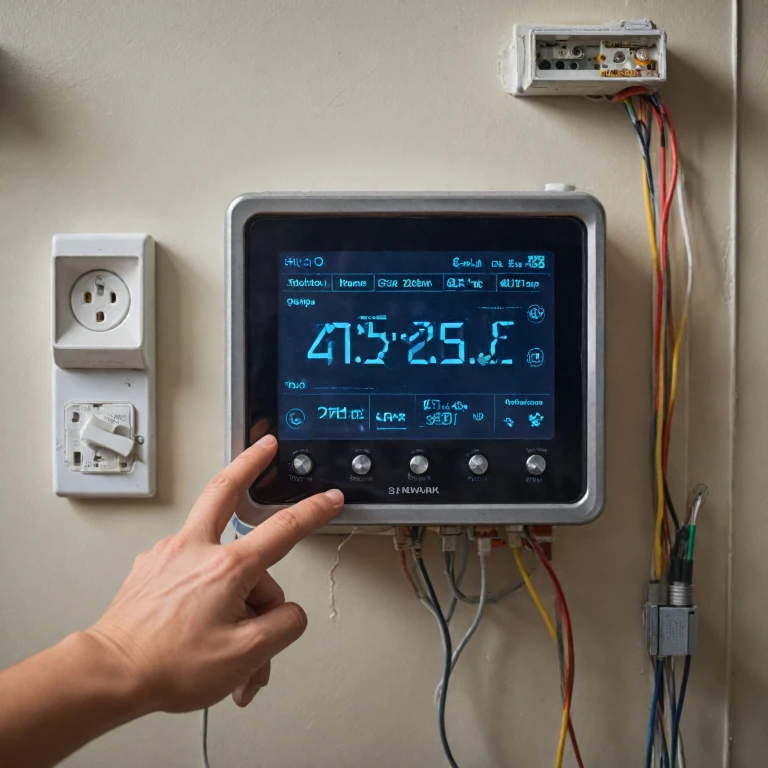Understanding the Basics of Smart Thermostat Power
Grasping the Essentials of Smart Thermostat Power
It's crucial to understand the basics of how your smart thermostat draws and uses power for efficient operation. These advanced gadgets, like the popular Nest Thermostat, rely on electrical power to function, whether it's for heating, cooling, or simply staying connected to your home's Wi-Fi.
The power source for thermostats can vary slightly:
- Hardwired Systems: Many thermostats are integrated into the HVAC system wiring, receiving direct power from the system itself.
- Battery-Powered Units: Some thermostats use batteries as the primary or backup power source. Regularly check the battery status to prevent interruptions.
Common components involved in delivering and maintaining this power include:
- Thermostat Wires: These wires are integral in connecting your thermostat to the HVAC system, crucial for receiving power effectively.
- HVAC System: An operational heating and air conditioning unit is often necessary for thermostat functioning since it supplies the needed power.
- Circuit Breakers: A tripped circuit can cause a sudden power loss, so ensure the breaker is in the 'on' position. Check the circuit breaker if facing power issues.
In the setup where multiple thermostats are used, as with some Google Nest systems, ensuring that each device is correctly wired and configured is vital. For comprehensive details on ensuring seamless power to your smart thermostat, you might find this guide on
troubleshooting smart home network issues an insightful read.
Common Causes of Power Loss in Smart Thermostats
Examining Frequent Power Loss Culprits in Smart Thermostats
One primary reason behind a smart thermostat not working as it should be is issues related to power. Understanding these typical causes can set the stage for effective troubleshooting:
- Wiring Problems: Check the wiring connections. Disconnected or loose wires can disrupt the system's power flow. Carefully inspect the wires inside the thermostat cover.
- Batteries: Some thermostats, such as older or non-connected models, rely on batteries for power. Verify if the batteries need replacement.
- Tripped Circuit Breaker: Your home's circuit breaker might have tripped. Resetting it could restore power to your system.
- HVAC System Power: A power issue in the HVAC system itself could be affecting your thermostat. Check if the heating or air conditioning unit is properly functioning.
- Drain Pipe and Safety Switch: An overflow in the air conditioner's drain pipe may trigger a safety switch, cutting power to prevent damage. Clear any blockages to resume operation.
- Thermostat Firmware: Though rare, certain thermostat models might have firmware issues that lead to occasional power loss. Update your firmware if it's outdated.
If your thermostat isn’t receiving power, identifying these common causes is crucial in resolving power issues. For an in-depth step-by-step guide to resetting different thermostats, you can consult this resource for reset procedures.
Step-by-Step Troubleshooting Guide
Tackling the Power Challenges
Diagnosing power problems with your smart thermostat can feel daunting, but breaking it down into manageable steps can simplify the process. To get started, you'll want to ensure that your power thermostat isn’t facing common obstacles. Here’s a straightforward guide:
- Check the Circuit Breaker: Circuit breakers are often a source of power issues. If the circuit breaker associated with your HVAC system has tripped, your thermostat might not be receiving power. Go to your breaker panel, identify the tripped circuit, and switch it back on.
- Inspect the Wiring: Power issues can sometimes be traced back to faulty or disconnected wires. Carefully remove the thermostat cover and check for any loose or disconnected wires. A Google Nest thermostat, for example, relies on specific wires to function. Ensuring secure connections can often resolve power outages.
- Examine the Safety Switch: Some thermostats have a built-in safety switch that can be inadvertently triggered. Make sure the switch isn’t engaged, as this can prevent the thermostat from working properly.
- Battery Assessment: If your thermostat uses batteries as a backup or primary power source, depleted batteries could be the cause of a power issue. Replace the batteries and check if the thermostat resumes normal operation.
- HVAC System Power: Sometimes, the issue might stem from the HVAC system itself. Ensure that your air conditioning or furnace is powered and functional as issues with these components can indirectly affect the thermostat’s power status.
- Investigating Outdoor Unit: If you have an air conditioning system with an outdoor unit, ensure it's receiving power and is not affected by a tripped breaker or blown fuse.
These are the fundamental steps to address power-related issues in your thermostat system. If at any point the problem seems too complex or you're unsure about handling the wiring safely, it's best to seek professional help without delay to avoid further complications.
When to Call a Professional
When to Seek Professional Assistance
While smart thermostats can be a user-friendly way to manage your home's climate, encountering persistent power issues might necessitate the intervention of a professional. Here are some scenarios when reaching out for expert help is recommended:
- Complex Wiring Issues: If your thermostat isn't receiving power despite checking the wiring connections, there might be more intricate problems with the HVAC system wiring that a technician can resolve.
- Replacing or Upgrading Thermostats: When switching to a new model like the Nest thermostat, compatibility issues with your existing HVAC system may arise. A professional can ensure a seamless transition without compromising the system's functionality.
- Repeated Circuit Breaker Trips: A tripped circuit breaker that's frequently occurring indicates deeper electrical faults, possibly related to the air conditioning or heating systems.
- Persistent Safety Switch Trips: Sometimes the safety switch in systems, such as the furnace's condensation drain pipe blockage, could cause the thermostat to lose power. It's vital for a technician to inspect and clear any blockages safely.
- Unclear Power Issues: Should you be unable to diagnose the power problem — after verifying circuit breakers, furnace switches, or batteries — calling a professional will help ensure your thermostat system is working effectively.
Consulting a certified HVAC professional should never be dismissed when your safety or the integrity of your heating and cooling systems is at risk. Their expertise can solve complex problems swiftly and accurately, saving you time and future costs.
Preventive Measures to Avoid Power Issues
Maintaining Optimal Power Supply for Smart Thermostats
While dealing with power issues can be frustrating, certain preventive measures can help ensure your smart thermostat remains operational. Making small but significant adjustments can prevent unexpected disruptions in your heating and cooling system.
- Regular Check-Up on Wiring: It's essential to regularly inspect the wires connected to your smart thermostat. Over time, wires can loosen, fray, or become disconnected, leading to power issues. Tighten any loose connections and replace damaged wires to maintain a healthy electrical system.
- Routine Battery Replacement: If your thermostat relies on batteries, it's crucial to change them periodically. Older batteries might not provide sufficient power, causing the thermostat to malfunction. Keep spare batteries at hand and set a reminder to check and replace them regularly.
- Inspecting Circuit Breaker and Safety Switch: A tripped circuit breaker or safety switch can cause a sudden power loss to your thermostat. Make it a routine to check your circuit breaker and ensure all systems are correctly set. If the breaker repeatedly trips, seek professional help, as it may indicate a deeper electrical issue.
- Maintain a Clean Drain Pipe: Furnaces and air conditioning systems often rely on a drain pipe to manage condensation. Blockages can cause water buildup, which may trigger the thermostat’s safety feature to shut down the system. Regularly clean the drain pipe to prevent this.
- Check the HVAC System: Regular maintenance of your HVAC system, including the furnace and air conditioner, can prevent power issues. This includes cleaning filters, checking for leaks, and ensuring all components are functioning efficiently. A well-maintained HVAC system supports consistent power to your smart thermostat.
Incorporating these preventive strategies can assist in keeping your thermostat working smoothly, reducing the risk of power-related issues. However, should problems persist, it's always wise to consult a professional for a more comprehensive solution.
Exploring Alternative Solutions
Exploring Alternatives to Prevent Repeated Power Issues
Power issues in smart thermostats can be frustrating, especially when they keep recurring. After trying troubleshooting steps, it’s often worthwhile to explore alternative solutions to address the root causes permanently.
Consider the following alternatives:
- Upgrade Your Wiring: Older wiring systems might not be equipped to handle modern thermostat demands. If there's a consistent problem with your thermostat receiving power, it might be time to upgrade the wiring or consult with an electrician to assess the situation.
- Switch to a C-Wire Adapter: Many smart thermostats, including popular models like the Nest thermostat, and other Google Nest products, function best with a continuous power supply. A common solution is to use a C-wire adapter, which can help ensure the thermostat stays powered without interruption.
- Install a New HVAC System Component: Sometimes the issue might not solely lie in the thermostat but rather in an incompatible or aging component within your HVAC system. Replacing older parts of your heating cooling system might help.
- Consider an Alternative Model: Not all thermostats are created equal. If you've been struggling despite applying all other fixes, look into models with different power requirements or perhaps newer iterations that address common power issues more effectively.
- Utilize Safety Switches: Implementing safety switches that trip at the right time can prevent ongoing power issues. They can cut the power in case of a fault and protect the system from damage.
- Regular Maintenance Checks: Preventive maintenance on your air conditioning and furnace units can reveal hidden issues that can lead to power failures. Regular checks ensure that your system is in top working order.
These options can provide a more holistic approach to ensuring your thermostat and overall HVAC system operate smoothly, preventing power disruptions and improving the lifespan of your devices. Consult with a professional for more targeted help if you find these solutions aren’t enough to solve your problem.

